iPhone 14 Pro To Have A Way Better OLED Screen Than The iPhone 14
A report a few days ago claimed the iPhone 14 Pro and the regular iPhone 14 will feature next-gen OLED screens unlike anything on the market. Even though most iPhone 14 panels will come from Samsung, they'll be better than what Samsung used for the Galaxy S22 flagship this year. But that report might not have been entirely accurate.
A new story says that only the iPhone 14 Pro and Pro Max will feature the next-gen OLED material that Samsung hasn't even used on its own phones yet. The iPhone 14 models will reportedly feature the same OLED material as the Galaxy S22.
iPhone 14 Pro vs. iPhone 14: The display differences
Even without any iPhone 14 rumors, we know what to expect from the iPhone 14 and iPhone 14 Pro models regarding display performance. All four devices will feature OLED panels, but they will not be identical.
The 6.1-inch iPhone 14 and 6.7-inch iPhone 14 Plus/Max will feature low-temperature polycrystalline silicon (LTPS) thin-film transistor (TFT) OLEDs. These are panels that run at a static 60Hz refresh rate.
Meanwhile, the 6.1-inch iPhone 14 Pro and 6.7-inch iPhone 14 Pro Max will have low-temperature polycrystalline oxide (LTPO) TFT OLED displays. These panels support ProMotion, which is Apple's dynamic refresh rate that supports rates between 10Hz and 120Hz.
Add in the recent iPhone 14 rumors, and we think the Pro models will get improved LTPO panels. The refresh rate should go as low as 1Hz refresh so that Apple can offer users always-on functionality.
Moreover, iPhone 14 rumors say the Pro models will feature pill-and-hole OLED display designs. The regular models will stick with the same notch as the one on the iPhone 13.
An industry insider said recently that the iPhone 14 models receiving displays from Samsung will feature new M12 OLED material. This will lead to display performance improvements concerning color accuracy and energy efficiency. The reports followed mid-February rumors that indicated Samsung decided against using the latest M12 OLED displays in the Galaxy S22.
The move helped Samsung cut costs on the Galaxy S22. But Samsung is still reportedly selling M12 OLED displays to Apple for the iPhone 14 series.
Next-gen OLED screen material
A brand new report from The Elec clears the air. The same Korean site mentioned the M12 OLED screens in February. The Elec now says that Apple will buy M12 and M11 OLED panels for its iPhone 14 models.
The iPhone 14 and 14 Plus/Max will get last year's M11 OLED screen tech, according to the report. The Galaxy S22 Ultra and Galaxy S22 Plus also feature M11 OLED displays. The entry-level Galaxy S22 has an even older OLED panel, packing M10 pixel materials.
The M12 OLED screens will go into the iPhone 14 Pro and iPhone 14 Pro Max. Samsung will apparently also use the more expensive M12 material for the foldable OLED displays of the Galaxy Z Fold 4 and Flip 4.
Separately, LG will also use different OLED display materials for the iPhone. LG calls its OLED material set RS. The Elec says the newest OLED material is called RS-L. This is supposedly the equivalent of the M12, and LG will supply RS-L panels for the iPhone 14 Pro Max. LG already supplies RS-K panels for the iPhone 13.
Interestingly, LG will also supply RS-L panels for the regular iPhone 14. While the differences between M12 and RS-L are unclear, iPhone 14 models featuring LG panels should still get LTPS screens running at 60Hz. It's just the iPhone 14 Pro Max that will utilize the LTPO variant.
More iPhone coverage: For more iPhone news, visit our iPhone 14 guide.


